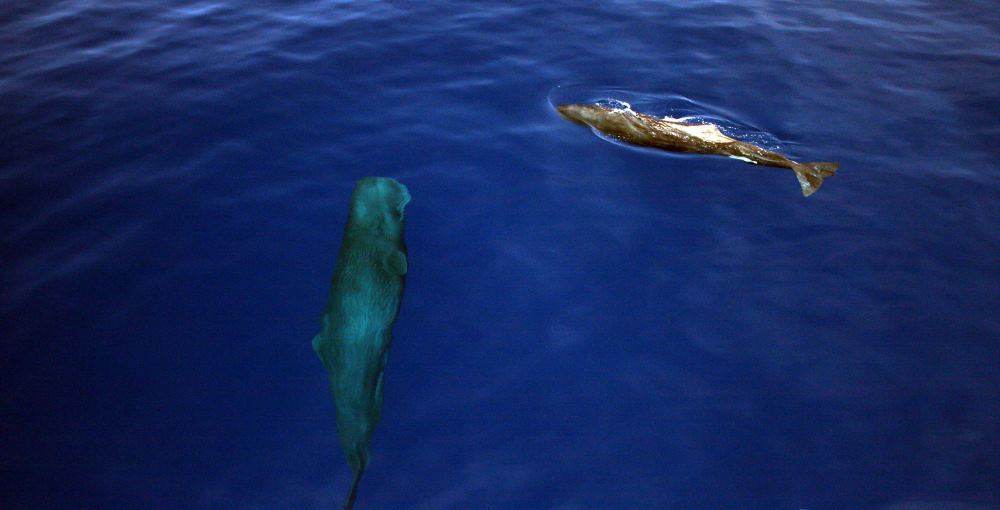Signs of culture were found in sperm whale communication methods.

It is known that dolphins have a certain strategy of communication with each other. This includes "language", and body movements and much more. Now researchers say that sperm whales can have their own culture. Shane Gero, a marine biologist from the University of Aarhus, Denmark, who works at the Marine Acoustics Laboratory, thinks so. He spent more than ten years tracking the migration paths of sperm whales living off Dominic Island in the Caribbean.
As it turned out, various groups of sperm whales have their own traditions, there are "language dialects." Dialects differ in the frequency and duration of clicks used by sperm whales when communicating with each other. Each group (clan) of sperm whales talks a little differently than other clans do.
In his study, Gero, along with his co-authors, develops the idea of the existence of a culture or even a “civilization” among sperm whales. In this paper, the author shows the replacement of sperm whale clans in the region, when two “cultural groups” of sperm whales near the Galapagos Islands went to a new place, and two new clans came to their habitat area. The author in his study tries to answer the question of what keeps the clans together. It also claims that instead of making any changes in their culture, sperm whales prefer to leave their former habitat.
')
“These cultural differences are part of their life, their authenticity,” says the scientist. The research results are published in the publication of the Royal Society Open Science . The first group of sperm whales, who lived near the Galapagos Islands, used a dialect that was named by scientists "Regular". Listen to the "conversation" of the representatives of this group here . The dialect of the second group was called “Plus-One”, its features are audible on this recording . The difference of the second dialect is a longer pause before the last click.
Between 1985 and 1999, scientists identified and described various sperm whales of these groups. Identification, including, was carried out using photographs. In the 90s, as the researchers write, the sperm whale population declined. In 2000, both groups left for a new region, and the causes of migration are unknown. There is an assumption that climate change played a role, but this must be proved.
In 2013 and 2014, scientists again studied this region of the Pacific Ocean, finding 463 new females. Moreover, these are individuals that were not previously recorded, they were not photographed, there is no similarity with the former inhabitants of the oceanic depths of this region. As it turned out, this group is also divided into two clans.

Accordingly, the dialects of these two new clans are different. The first dialect was named “Short”, and the second - “Four-Plus”. Two dialects also differ in the duration of pauses between clicks.
Scientists, besides studying the dialects and cultural peculiarities of different clans of sperm whales, are now trying to figure out why two animal clans left the region of the former habitat, and two new clans appeared here.
Gero calls this phenomenon the “physical and geographical movement of cultures,” like the great migration of peoples among people. Among animals, there is often a decrease or increase in the size of populations, but replacing some groups with others, like what was observed in sperm whales, is rare.
A significant point in the relocation, according to Hero, is that individual clans of whales were able to retain their “cultural” features, including dialect and some habits. It is these elements that distinguish the clans. “It is assumed that culture is critical for them. These sperm whales prefer to leave and preserve their culture than to adapt to new conditions, ”said the scientist.
In his opinion, the experts who are engaged in environmental protection should take into account the results of these studies. “For a diversity of sperm whales, a crucial factor is the difference in their cultures,” Gero said. The scientist also fears that with global climate change, sperm whales may one day get into a situation where they simply have nowhere to move.
Now marine biologists participating in the study of sperm whale populations are studying the communication features of these animals. In their opinion, the number of clicks and pauses, the duration of sounds and their arrangement in the “phrase” are important. Thanks to these features, scientists can identify and study different groups of sperm whales, tracking their behavioral characteristics, migrations, and "cultural traditions."
According to biologists, sperm whales have many common behavioral features compared to primates. And those and others have a social life, an opportunity to learn, they interact with each other, share food, observe certain traditions and communicate with the help of sounds.
Source: https://habr.com/ru/post/398525/
All Articles